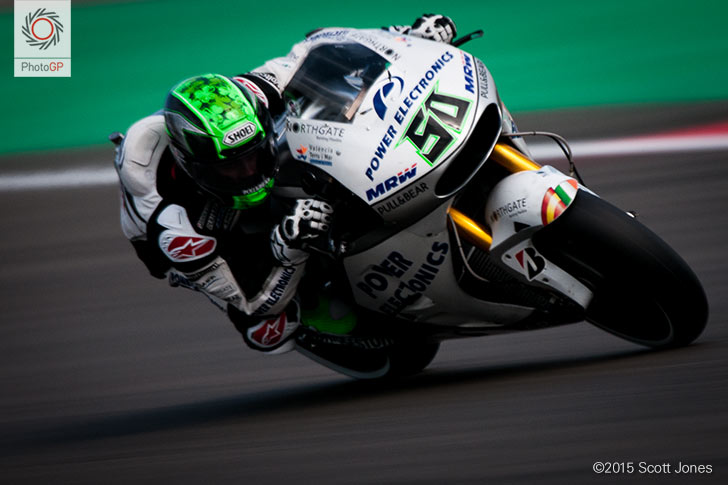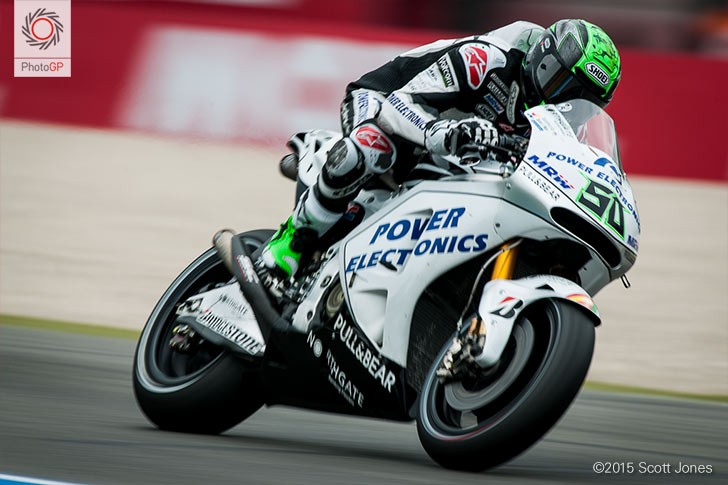Interview: Eugene Laverty
Eugene Laverty is a fast rider. At certain times in his career he has had a bike that allowed him to show it, and at other times he has not. The first time I interviewed him was at Miller Motorsports Park in 2009 when he was battling with Cal Crutchlow for the World Supersport title. Since then, and before then, he has had an interesting career that has led to his current position with the Aspar Honda MotoGP team. As the latest in a series of interviews about how young riders find a way to Grands Prix, I spoke to Laverty at Mugello about how he got started riding and racing. (The previous interviews are with Danny Kent, Young Lee, Daniel Costilla, Gabriel Hernandez III, Nicky Hayden, Wayne Gardner, and his son, Remy Gardner.
Scott Jones: How did you get started racing motorbikes?
Eugene Laverty: I started off on motocross bikes at three years old. I did some racing with my brothers [Michael and John] and then went road racing for the first time when I was 14.
SJ: Did you ride any minibikes, or any other small displacement bikes besides that first dirt bike?
EL: Yes, but not in competition. I think some of the best fun you can have on bikes is whenever you ride one that’s too small for you, because then you feel in control and in charge, so whenever you ride minibikes it’s always good fun.
SJ: Before your road racing started, did you do any flat track or speedway or anything else?
EL: No, it was only motocross with my brothers. It was just a hobby for fun when we were kids.
SJ: So you didn’t race then?
EL: Yes, I raced for a few years, but then my brothers moved to road racing. [Motocross] was expensive by myself, so I had to stop for a yew years, when I was 11 or 12. But that was good because when you’re that age you almost take it for granted, and when it’s taken away it makes you hungry. So when I got the opportunity to go road racing I took it very seriously.
At that time, 2001, I did 125cc for one year in Ireland, then immediately after went to the British championship. From 125 to 250cc, that was the path at that time, with the 2-strokes. But it always changes. Shortly after that 4-stroke became the thing. I started in 2001, but for kids who started, maybe, 2006, the sooner you got on 4-strokes the better.
But for me it was 125cc 2-strokes, and from there I was picked up by the Red Bull Rookies Project in the U.K., and that stepping stone was 125, Supersport, Superbike. That wasn’t the Red Bull Rookies as we know it now, that was the Red Bull Rookies Honda Team, a selection process for picking new riders. There were two riders in 125, and Jonathan Rea in Supersport. Then I moved to Supersport and Jonathan stepped up to Superbike.

SJ: So was it this Red Bull Team that led to your coming to the 250cc GP class?
EL: No, I did the British Championship with the Red Bull Team, then went to British Supersport with the same team, and then I came to 250cc Grands Prix. I did two difficult years in 250s. It was a good school of course, to ride a 250, it’s is a good bike to learn on. But I wasn’t on competitive machinery, so I moved back to Supersport but on World Championship level.
But I’m a firm believer that there is no correct school, a fast rider is a fast rider. It doesn’t matter if you’re on a 125, 250, 600 4-stroke, or 1,000cc Superstock. A fast rider is a fast rider, and if they’re good enough, you can put them on any bike and they can do it. In the past everyone thought 250 was the only school for a rider to get to 500cc GP, or MotoGP when it became 4-stroke.
Then 250 changed to Moto2 and it still produces the world champion. So it’s not about which way you go, it’s about opportunity and if you’re fast enough then hopefully you get there.
SJ: What was the competition in the CEV like?
EL: I did one year, my third year, in the Spanish Championship. Unfortunately, at that time, we were riding against Grand Prix riders. Alvaro Bautista came thorough the championship, Jorge Lorenzo, also Aleix Espargaro, Nico Terol… I was fighting for the podium, but I wasn’t on a GP bike so it was difficult at that time. But it was a great class with a lot of great riders.
SJ: You said you weren’t on a competitive bike when you were in 250cc Grands Prix, so was the move to World Supersport mainly to get on better equipment?
EL: I think I was fortunate that whenever I made the choice to go to 250 Grands Prix, I had been racing British Supersport with Crutchlow, with Sykes, with Camier. Then I went to 250 Grands Prix and had a difficult time, but the guys, Crutchlow, and Sykes, and Camier went to British Superbike, and they were winning races. So I was fortunate that people could do the math and put two and two together and understand that Hey, Eugene was battling with those guys two years ago. So they gave me the opportunity in World Supersport and I won my second race. So I think I was fortunate, because of those guys’ success, it helped me.

SJ: You said earlier that you think a fast rider is a fast rider regardless of the background. Nicky Hayden said the same thing. But still I’m curious, do you think you might have been better prepared for road racing if you had done something besides motocross?
EL: I think it’s becoming clearer now with the young guys, especially the Spanish, how much dirt track, supermoto, motocross, everything they do helps their skills. So it’s a good idea, because each bike is a different style of riding. Moto2, you can see in corner entry that the guys slide the bike more, so maybe supermoto helps with that. Even on Bridgestones, the bike spins a lot on its side, that’s why some guys like dirt track. So it’s good to have a good skill set and each discipline can help that.
SJ: I saw some video of you riding a supermotard after Le Mans, I think. Was that just for fun, or were you working on new skills that might help you in MotoGP?
EL: For me, I’d like to try dirt track but I don’t feel that’s something that’s important for me because I’ve been riding a different type of tire for the last lot of years and that tire allowed me to slide the bike around a lot. But one area I’d like to improve on is corner entry, having confidence when the bike is sliding in sideways. And that’s why I think the supermotard helps, especially for this Honda. I think Marquez is almost riding the Honda like a supermotard, so I think it helps.
Thanks to Eugene and the Aspar Honda media folks for this interview.
Photographs: ©2015 by Scott Jones / PHOTO.GP – All Rights Reserved
[mgallery keyword=”Eugene Laverty”]
Eugene Laverty Interview










Please sign in or register to contribute a comment or question.